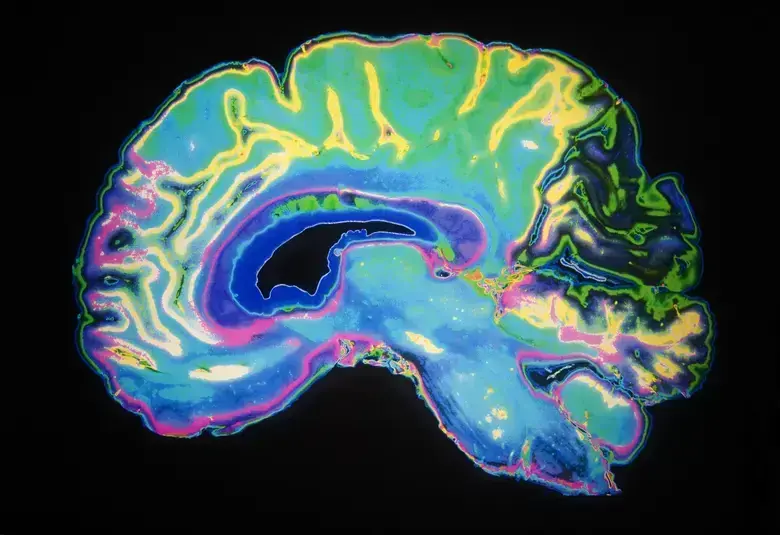Clinicians say a person is in remission, but would that patient agree? What do patients look for in a good response to treatment? The answer seems to lie in a life being meaningful, in a return to good functioning, and – at least a little – in pleasure. The difference between physicians’ goals and patients’ goals is important since discordance influences outcome.
임상의가 환자에게 관해(remission) 상태라고 말하면, 환자도 이에 대해 동의할까요? 좋은 치료 효과에 대한 환자들의 기대는 무엇일까요? 의미 있는 삶, 정상 기능의 회복, 그리고 적어도 약간의 기쁨을 누리는 것 등 이야말로 환자들이 치료 결과로 얻고자 하는 것일 수 있습니다. 의사와 환자의 목표 불일치는 치료 결과에 영향을 줄 수 있기 때문에 중요한 사안입니다.
Diversity in depression was the subject for Koen Demyttenaere (University Hospital Gasthuisberg, Leuven, Belgium). And he started with the astonishing number of ways in which DSM-5 allows depressed patients to be different.
Koen Demyttenaere (벨기에 뤼벤, 개스츄스버그(Gasthuisberg) 대학병원) 교수는 우울증의 다양성을 연구 주제로 다뤘습니다. DSM-5항목 및 기준에 따라 우울증 환자들을 다양하게 분류하였습니다.
Given that someone can be classed as having major depressive disorder (MDD) based on any five symptoms from a list of nine, there are potentially 227 unique profiles. And two patients, both diagnosed as having depression, can – at least in theory – have only one symptom in common.
9가지 항목 중 5가지 증상을 토대로 어떤 사람을 주요우울장애(MDD)가 있는 환자로 분류할 수 있다고 가정하면, 잠재적으로 227가지 고유한 프로필이 존재하게 됩니다. 또한 이론상으로 우울증으로 진단을 받은 두 명의 환자는 단 한가지 증상만을 공통적으로 가질 수 있습니다.
A striking feature of patients included in the STAR*D study is that 21% had anhedonia but not depressed mood – a phenomenon which is sometimes covered by the paradoxical term of “depression without depression”.
STAR* D 연구에 포함된 환자들이 보인 두드러진 특징은 21%가 우울감 없이 무쾌감증(anhedonia)을 보였다는 것인데, 이는 종종 역설적 표현인 “우울증상이 없는 우울증”으로 설명됩니다.
This led Professor Demyttenaere into the second of his themes – the fact that the absence of positive affect plays little part in assessment of outcome. Is it that psychiatrists are too little interested in pleasure? he asked.
위의 연구 결과로부터 Demyttenaere 교수는 다음의 두 번째 연구 주제를 도출했습니다: ‘긍정적 감정의 부재 여부는 증상 개선 정도 평가에 중요하게 고려되지 않는다.’ 그는 “정신과 의사들이 즐거움에 대해 너무 관심이 없는 것은 아닐까”라고 질문합니다.
Neither HAM-D nor MADRS assess positive affect; and they assess hedonic function only poorly.
HAM-D나 MADRS 모두 긍정적인 감정을 평가하지 못하며, 단지 쾌락 기능만을 일부 평가합니다.
To combat that bias, he favors use of the Center for Epidemiological Studies – Depression (CES-D) scale, since six of the twenty items deal with negative mood and a further four with lack of positive mood.
이러한 편향성을 방지하기 위해, Demyttenaere 교수는 Center for Epidemiological Studies – Depression(CES-D) 척도 이용을 선호하는데, 이 척도는 20가지 항목 중 6가지가 부정적인 기분을 다루며, 4가지 항목은 긍정적인 기분의 결여를 다루고 있기 때문입니다.
Anhedonia is arguably the most specific feature of depression, he suggests.
Demyttenaere 교수는 무쾌감증이 틀림없이 우울증의 가장 특이적인 증상이라고 제안합니다.
Koen Demyttenaere and colleagues have also developed the Leuven Affect and Pleasure Scale (LAPS) to take better account of positive affect and anhedonia and more adequately reflect the patient’s perspective.
Koen Demyttenaere 교수와 그 연구진들은 긍정적인 감정과 무쾌감증을 더 잘 고려하고, 환자의 관점을 더 적절하게 반영하기 위해 Leuven Affect and Pleasure Scale(LAPS)도 개발했습니다.
Diversity in symptoms, expectations and beliefs
증상, 기대 및 믿음의 다양성
We are faced with diversity among patients in their depressive symptoms, and with a bewildering diversity of scales used to assess response to treatment. We also have diversity of expectations – between patients themselves, and between patients and clinicians. And this is important since it affects outcome.
우리는 우울 증상에서의 환자의 다양성과, 치료에 대한 반응을 평가하기 위해 사용되는 수많은 척도의 혼란스런 다양성이라는 상황에 놓여 있습니다. 또한, 환자들 간에 그리고 환자와 의사 간에 발생하는 기대의 다양성도 있습니다. 이러한 사안들은 치료 결과에 영향을 미치기 때문에 중요합니다.
The top priorities for patients are having a meaningful life, enjoying life, and being satisfied with themselves. For physicians they are a reduction in negative feelings, a reduction in depressed feelings and anhedonia, and social life and leisure.
환자의 최우선 순위는 의미 있는 삶을 영위하고, 삶을 즐기며, 환자 자신에 대해 만족하며 사는 것입니다. 의사의 입장에서는, 부정적인 감정을 줄이고, 우울한 감정과 무쾌감증을 감소시키며, 사회생활과 여가생활을 즐기도록 하는 것이 최우선 순위입니다.
The greater the divergence between patient and physician at baseline, the poorer the treatment outcome at six months.
치료를 시작할 시점에 환자와 의사 간의 치료목표 차이가 클수록, 치료 시작 후 6개월 시점의 치료결과는 더 좋지 않습니다.
Tailoring treatment
맞춤 치료(Tailoring treatment)
Patients are more likely to perceive a reduction in depressive symptoms with pharmacological treatment if they believe their condition is less influenced by social factors, if they believe their doctor has understood their problem, and if the consultation has lasted longer.
환자 본인의 상태가 사회적 요인의 영향을 덜 받는다고 생각하는 경우, 담당 의사가 환자 본인의 문제를 이해하고 있다고 믿는 경우, 상담이 더 오래 지속되었던 경우일수록 환자들은 약물 치료에 의한 우울 증상 감소를 인지하는 경향이 큽니다.
Outcome is also influenced by demographic diversity. It is often said that the 47% response to first-line treatment in STAR*D is disappointing, but in certain groups the rate was substantially better. Of patients with 14 years or more of education, no history of trauma or distress, and who were female, 63% responded.
결과는 인구학적 다양성에 의해서도 영향을 받습니다. STAR*D 연구에서 일차 치료제에 47%의 환자만이 반응(response)을 보인 것은 실망스러운 결과라고 종종 언급되지만, 일부 환자군에서의 현저히 높은 반응률이 나타났습니다. 정신적 외상이나 고통에 대한 병력이 없으며, 14년 이상 교육을 받은 여성 환자들에는 63%의 반응률이 나타났습니다.
Symptomatic remission not sufficient
증상의 관해 (Symptomatic remission)만으로는 충분하지 않음
These themes were taken up by Malcolm Hopwood (University of Melbourne, Australia) who argued that restoring function is the cornerstone of remission but also questioned whether the physician’s concept of remission aligned with that of patients.
기능 회복(restoring function)이 관해의 기본이 된다고 주장한 Malcolm Hopwood 교수(호주, 멜버른 대학교)는, 또한 의사가 생각하는 관해의 개념이 환자들의 생각과 일치하는지에 대한 의문을 제기하였습니다.
Changes in negative affect at week one predict remission at week six -- but with only half the effect size of changes in positive mood. If we asked about positive affect in a more thoughtful and interested way, we might be able to tailor treatment more effectively to the individual patient and the presence or absence of early response, he suggested.
치료 첫 주의 부정적 증상의 변화를 통해 6주째의 관해상태 도달을 예측하지만, 긍정적인 기분 변화에 대한 효과 크기(effect size)는 절반에 그쳤습니다. Hopwood 교수는 더 사려 깊고 흥미로운 방식으로 긍정적인 감정에 대해 질문을 했더라면, 환자 개개인에게 그리고 초기 반응 유무에 대해 더 효과적으로 맞춤치료를 할 수 있을 것이라고 제안했습니다.
Professor Hopwood and colleagues have developed the CHEER index -- a tool for primary care physicians to use in identifying emotional blunting in patients with depression. At the very least, it acts as a stimulus to start a conversation about what patients most value as the outcome of treatment.
Hopwood 교수와 그 연구진은 일차 진료(primary care) 의사들이 우울증 환자의 정서적 둔화(emotional blunting)를 선별할 수 있는 도구인 CHEER index를 개발했습니다. 적어도, 이 CHEER 지수는 환자들이 치료 결과로 가장 중요하게 여기는 것이 무엇인지에 대한 대화를 시작하는 자극제 역할을 합니다.
Our judgment is that symptomatic remission is not sufficient. Patients value most the functional benefits, particularly factors such as being able to return to work.
증상 관해만으로는 충분치 않다는 것이 우리의 판단입니다. 환자들은 기능 및 수행능력의 개선, 특히 업무 복귀 가능 여부를 가장 중요하게 여깁니다.
In panel discussion about the role of psychotherapy, Professor Hopwood was asked about patients’ pursuit of a meaningful life. We have a role in helping patients achieve that, whatever the therapeutic route, he suggested. And Stephen Stahl (University of California San Diego, USA), who chaired the session, added that not having depression might be necessary for having a meaningful life, but was not in itself sufficient.
심리치료의 역할에 대한 패널 토론에서, Hopwood 교수는 환자가 추구하는 의미 있는 삶에 대해 질문 받았으며, 치료 방법이 무엇이든 간에 의사의 역할은 환자들이 의미 있는 삶을 추구하는 것을 돕는 데 있다고 답변했습니다. 이번 패널 토론 세션의 의장인 Stephen Stahl(미국, 캘리포니아 대학교 샌디에고) 교수는 우울증이 없는 상태가 의미 있는 삶을 사는 데에 필요할 수 있지만, 그 자체만으로는 충분하지 않다고 덧붙였습니다.
These themes were taken up by Malcolm Hopwood (University of Melbourne, Australia) who argued that restoring function is the cornerstone of remission but also questioned whether the physician’s concept of remission aligned with that of patients.
기능 회복(restoring function)이 관해의 기본이 된다고 주장한 Malcolm Hopwood 교수(호주, 멜버른 대학교)는, 또한 의사가 생각하는 관해의 개념이 환자들의 생각과 일치하는지에 대한 의문을 제기하였습니다.
Changes in negative affect at week one predict remission at week six -- but with only half the effect size of changes in positive mood. If we asked about positive affect in a more thoughtful and interested way, we might be able to tailor treatment more effectively to the individual patient and the presence or absence of early response, he suggested.
치료 첫 주의 부정적 증상의 변화를 통해 6주째의 관해상태 도달을 예측하지만, 긍정적인 기분 변화에 대한 효과 크기(effect size)는 절반에 그쳤습니다. Hopwood 교수는 더 사려 깊고 흥미로운 방식으로 긍정적인 감정에 대해 질문을 했더라면, 환자 개개인에게 그리고 초기 반응 유무에 대해 더 효과적으로 맞춤치료를 할 수 있을 것이라고 제안했습니다.
Professor Hopwood and colleagues have developed the CHEER index -- a tool for primary care physicians to use in identifying emotional blunting in patients with depression. At the very least, it acts as a stimulus to start a conversation about what patients most value as the outcome of treatment.
Hopwood 교수와 그 연구진은 일차 진료(primary care) 의사들이 우울증 환자의 정서적 둔화(emotional blunting)를 선별할 수 있는 도구인 CHEER index를 개발했습니다. 적어도, 이 CHEER 지수는 환자들이 치료 결과로 가장 중요하게 여기는 것이 무엇인지에 대한 대화를 시작하는 자극제 역할을 합니다.
저희 담당자는 과학적 근거를 토대로 심포지엄의 주요 자료를 선정합니다. 본 페이지의 의견이 반드시 룬드벡의 의견을 반영하지는 않습니다.




